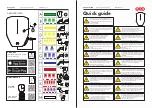
WARNING!
Do not use the cargo tie downs located on
the load floor. Improper usage of the tether
can lead to a failure of an infant or child
restraint. The child could be badly injured or
killed.
Many, but not all, restraint systems will be
equipped with separate straps on each side,
with each having a hook or connector for attach-
ment to the lower anchorage and a means of
adjusting the tension in the strap. Forward-
facing toddler restraints and some rear-facing
infant restraints will also be equipped with a
tether strap, a hook for attachment to the tether
strap anchorage and a means of adjusting the
tension of the strap.
First, loosen the child seat adjusters on the
lower straps and on the tether strap so that you
can more easily attach the hooks or connectors
to the vehicle anchorages. Next, attach the
lower hooks or connectors over the top of the
anchorage bars, pushing aside the seat cover
material. Then, locate the tether anchorage
directly behind the seat where you are placing
the child restraint and attach the tether strap to
the anchorage, being careful to route the tether
strap to provide the most direct path between
the anchor and the child restraint. There are
two top tether anchorages located on the
back of the seat, behind the gap panel. They
are not visible until you fold the gap panel
down. Do not use the cargo tie down hooks
located on the floor behind the seat. Finally,
tighten both straps as you push the child re-
straint rearward and downward into the seat,
removing slack in the straps according to the
child restraint manufacturer’s instructions.
WARNING!
Improper installation of a child restraint to the
ISOFIX anchorages can lead to failure of an
infant or child restraint. The child could be
badly injured or killed. Follow the manufac-
turer’s directions exactly when installing an
infant or child restraint.
Installing Child Restraints Using The
Vehicle Seat Belts
The seat belts in the passenger seating positions
are equipped with an Automatic Locking Retractor
(ALR to secure a Child Restraint System (CRS).
These types of seat belts are designed to keep the
lap portion of the seat belt tight around the child
restraint so that it is not necessary to use a locking
clip. The ALR will make a ratcheting noise if you
extract the entire belt from the retractor and then
allow the belt to retract into the retractor. For
additional information on ALR, refer to “Automatic
Locking Mode” description under “Seat Belts in
Passenger Seating Positions” section. The chart
below defines the seating positions with an Auto-
matic Locking Retractor (ALR) or a cinching latch
plate.
Driver
Center
Passen-
ger
First Row
N/A
N/A
N/A
Second
Row
ALR
ALR
ALR
•
N/A — Not Applicable
•
ALR — Automatic Locking Retractor
56
Summary of Contents for 2013 Grand Cherokee
Page 1: ...Grand Cherokee O P E R AT I N G I N F O R M AT I O N...
Page 2: ......
Page 3: ......
Page 4: ......
Page 6: ...2...
Page 11: ...7...
Page 66: ...62...
Page 91: ...87...
Page 92: ...88...
Page 93: ...89...
Page 165: ...INSTRUMENT CLUSTER 161...
Page 187: ...Compass Variance Map 183...
Page 218: ...Operating Tips Chart 214...
Page 296: ...292...
Page 372: ...368...
Page 395: ...391...
Page 396: ...392...
Page 397: ...10 INDEX 393...
Page 407: ......
Page 408: ...Chrysler Group LLC 13WK741 126 ENG AB Printed in Europe 13...
















































